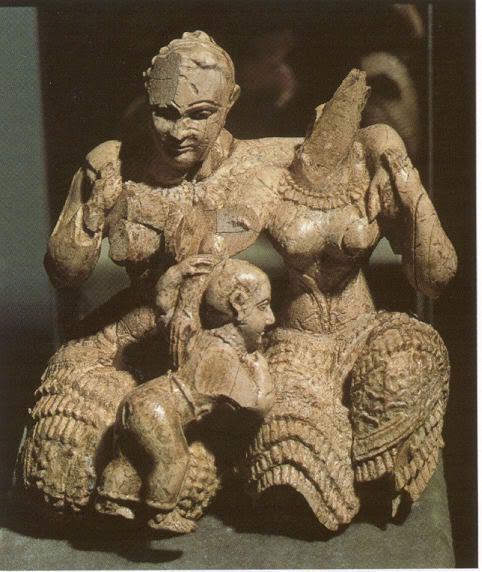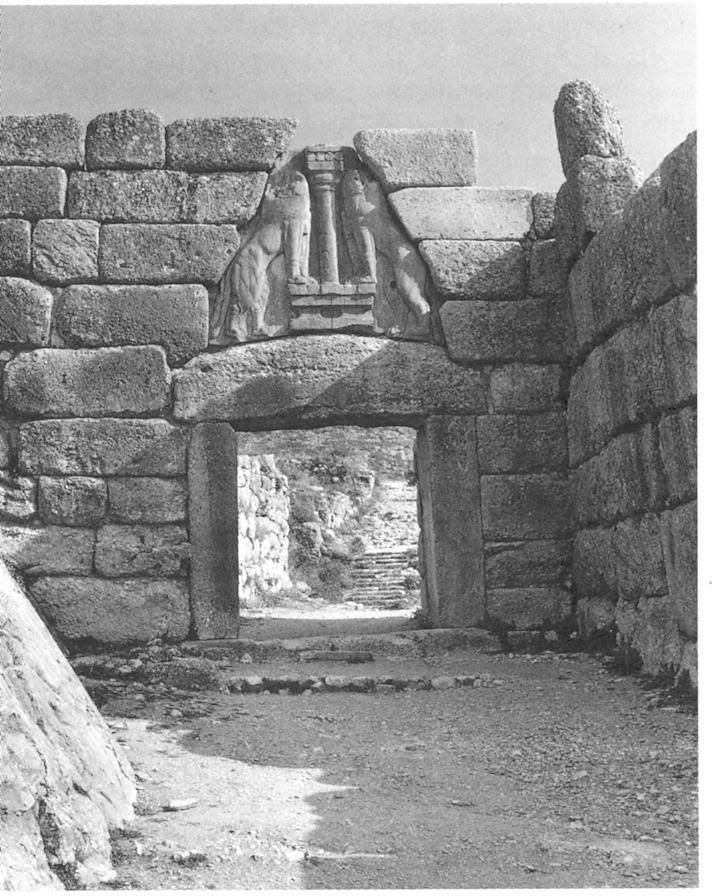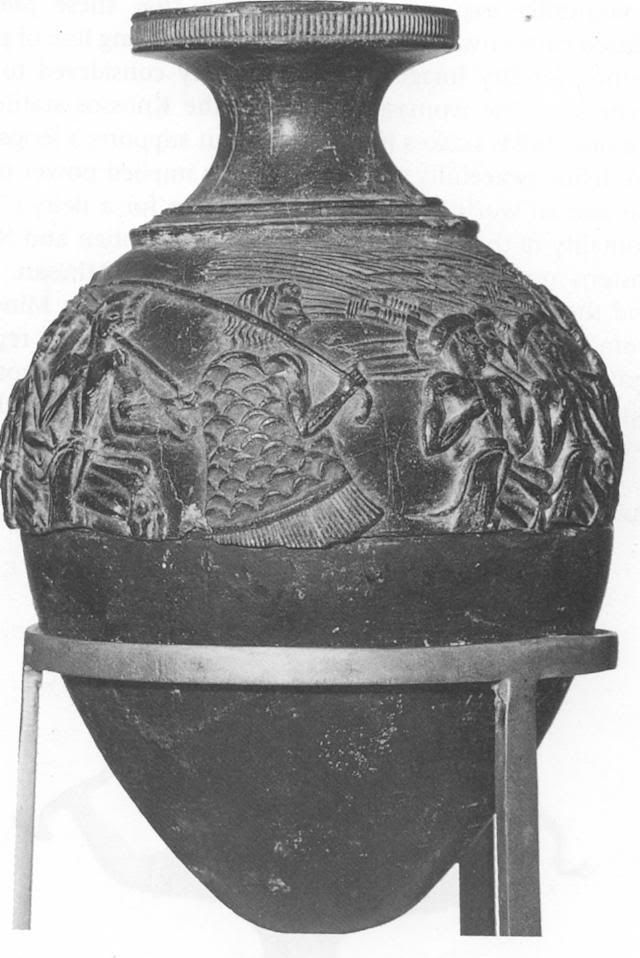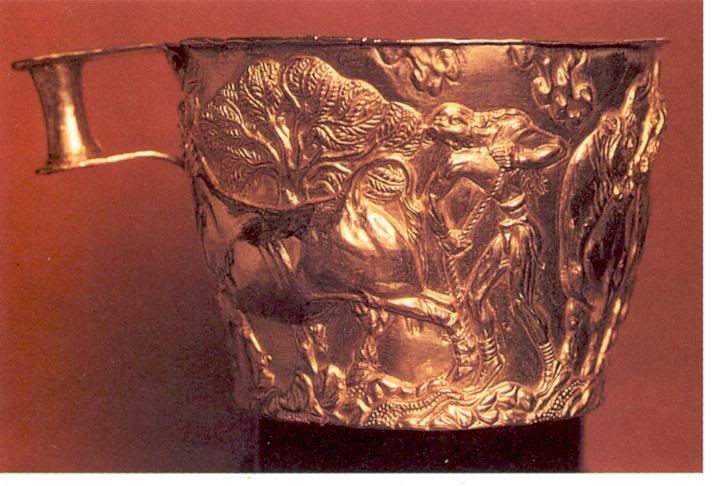The fairy princess decided to plan a surprise ball tomorrow. Periwinkle Cupcake Quesadilla decides to help her friends by making them all brand new dresses to make sure they all get noticed while they're dancing. She is making two different styles of dress: a lily dress and an iris dress. The lily dress requires four petal; while the iris dress needs eight. She was only able to pick 136 petals in such short notice. She also want to decorate the dresses with pixie dust to make sure it sparkles under the moonlight. Peri the Fairy only has 64 thimbles of pixie dust since convincing the pixies to sell the dust is very hard. The lily dress needs four thimbles of the pixie dust for just the right amount of glitter and the iris gown only needs two. In Peri's experience the lily dress has an attention capturing factor (ACF)of four male fairies, not including old men and ugly guys. The ACF of the iris dress is six. How many of each dress should she make to maximize her and her friends ACF?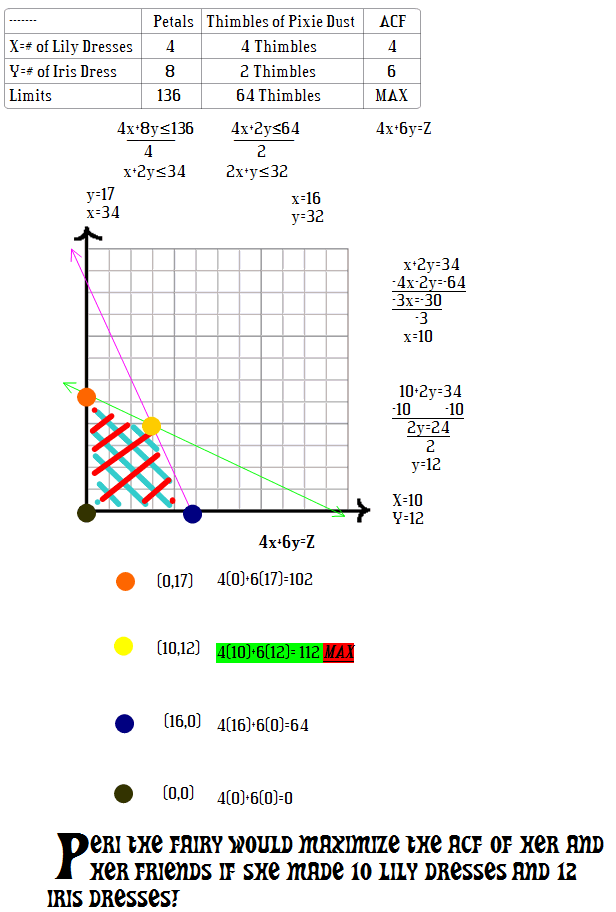
Newest Assignments and Dates (If assignment is online it shall be stated below)
- 03-17-2008 - 03-21-2008 -Spring Break (FREEDOM)
- 03-21-2008 -Art History Outline and images
- Still during spring break: Read Lord of the Flies for techniques/devices, 3 allusions due.
Saturday, October 13, 2007
Discrete -Word Problem-
Posted by
Christina
at
10/13/2007 11:33:00 PM
1 comments
![]()
![]()
Labels: Discrete
Friday, October 12, 2007
Econ -Unit 1- Chap 2 Notes
Chapter 2: The Economizing Problem The Foundation of Economics Unlimited Wants Scarce Resources Resource Categories ~Investment: the process of producing and purchasing capital goods ~Capital goods satisfy wants directly ~Consumer goods do so indirectly by aiding the production of consumer goods ~Entrepreneur: takes the initiative in combining the resources of land, capital, and labor to produce a good or service -Makes the strategic business decisions -Commercializes new products, new production techniques, etc… -Has no guaranteed profit Resource Payments Relative Scarcity ~Their scarcity constrains productive activity and output Economics: Employment and Efficiency Full Employment: Using Available Resources Full Production: Using Resources Efficiently ~This means apportioning limited resources among firms and industries in such a way that society obtains the combination of goods and services it wants the most Production Possibilities Table Assumptions ~Pizzas: symbolize consumer goods ~Industrial robots: symbolize capital goods The Need for Choice ~To increase the production of capital goods we must shift resources away from the production of consumer goods and vice versa ~A shift of resources to consumer goods catches up with society over time as the stock of capital goods dwindles, with the result that some potential for greater future production is lost ~A shift of resources to capital goods forgoes current consumption, thereby freeing up resources that can be used to increase the production of capital goods Production Possibilities Curve ~The curve is a production frontier because it shows the limit of attainable outputs ~To obtain the various combinations that fall on the production possibilities curve, society must achieve both full employment and productive efficiency ~Points lying inside the curve are also attainable, but they reflect inefficiency ~Point lying outside are unattainable with the current supplies of resources and technology Law of Increasing Opportunity Cost Shape of the Curve Economic Rationale ~It will take more and more of such resources and greater sacrifices of capital goods to achieve each increase of 1 unit in the production of consumer goods ~This lack of perfect flexibility, or interchangeability, on the part of resources is the cause of increasing opportunity costs Allocative Efficiency Revisited ~Although total benefits rise when society consumes more consumer goods, marginal benefits decline Unemployment and Productive Inefficiency A Growing Economy Increases in Resource Supplies ~Ex: a growing population will increase the supplies of labor and entrepreneurial ability ~Labor quality usually improves over time ~The development of irrigation programs, for example, adds to the supply of arable land ~The greater abundance of resources will result in a greater potential output of one or both products at each alternative ~Society will have achieved economic growth in the form of expanded potential output Advances in Technology The growth is a result of: ~Increases in supplies of resources ~Improvements in resource quality ~Technological advances Present Choices and Future Possibilities A Qualification: International Trade Pasted from <file:///C:\Users\Joyce\Documents\School\Physiology\Chapter%202.doc>
Posted by
Christina
at
10/12/2007 11:17:00 PM
0
comments
![]()
![]()
Physiology -Chap 4- Outline
Types of Tissues and Their Origins Four types of body tissue: Epithelial tissues develop from all three P.G.L. Connective forms from Mesoderm Nervous is made from Ectoderm Most cells within a tissue are anchored down, some move freely to hunt invaders. During growth and embryonic development many cells move more freely CELL JUNCTIONS: 5 types Tight Adherins Desmosomes: Contain plaque and have cadherins that extend into adjacent cells membranes. Unlike Tight Junction Adhesion belt Adherens Junctions Gap Junctions Desmosome Junction Basement Membrane Hemidsmosome Junction Adherens Junctions the plaque does not attach to microfilaments. They instead attach to intermediate filaments that contain the protein keratin. Prevent epidermal cells from pulling apart during contraction Hemidesmosomes: Resemble Desmosomes, but do not link adjacent cells. They look like half a Desmosome. The transmembrane glycoprotein in this junction are integrins. Integrins attach to intermediate filaments and to the protein laminin in the basement membrane (meaning Hemidsmosomes attach cells not to each other but to the basement membrane). Gap Junctions: Membrane protein, connexins forms fluid tunnels call connexons that connect neighboring cells. Plasma membranes are not fused together tightly; there is a narrow intercellular gap. EPITHELIAL TISSUE Epithelial tissue consists of cells arranged in continuous sheets, in single or multiple layers. Since there are so many junctions, there are little intercellular space between plasma membranes. Different surfaces differ in structure. The basement membrane has two layers. BASEMENT MEMBRANES AND DISEASE Basement membranes can thicken in certain conditions due to an increase of collagen and laminin. It can lead to blindness and kidney failure if left untreated. Epithelial cells are subjected to physical stress and injury. High rates of cell division allows epithelial to renew itself Epithelial jobs: Two types of epithelial tissue: Vocab: Primary Ectoderm: One of three layers the body tissues develop from Endoderm: One of three layers the body tissues develop from Mesoderm: One of three layers the body tissues develop from Cell Tight Adherens Plaque: Dense layer of proteins on inside of plasma membrane Cadherins: Transmembranes glycoprotein. Joins cells in Adherins Junctions Adhesion Desmosomes: One of five types of junctions. Contain plaque that binds to intermediate filaments that contain keratin. Hemidesmosome: One of five types of junctions. Similar to desmosomes, but that it contains intergins instead of cadherins and attaches to laminin on the basement membrane. Intergins: Present in Hemidsmosomes. Tranmembrane glycoprotein. Attaches to intermediate filaments on the inside and laminin on the outside. Laminin: Protein located in the basement membrane. Gap Connexins: Membrane protein used in gap junctions. Forms connexons. Connexons: Tiny fluid filled tunnel formed by connexins. Forms gap junctions. Apical Lateral Surface: One of three surfaces of the epithelial. Faces two adjacent cells on. Basal Basement Avascular: Lacks blood supply Covering Glandular Pasted from <file:///C:\Users\Joyce\Documents\School\Physiology\physiology%20notes.docx> ****************************** COVERING AND LINING EPITHELIUM Two main characteristics: Types of covering and lining: Secretion: Production and release of substances such as mucus, sweat, or enzymes Absorption: Intake of fluids or other substances such as digested food frm. intestinal tract. Endothelium: Kind of simple squamous. Lines heart, blood vessels, and lymphatic vessels Mesothelium: Kind of simple squamous. Forms serious membranes Microvilli: Fingerlike cytoplasmic projections; increases surface area of plasma membrane Goblet Pasted from <file:///C:\Users\Joyce\Documents\School\Physiology\physio.%20111-118.docx> ***************** COVERING AND LINING EPITHELIUM Two main characteristics: Types of covering and lining: Secretion: Production and release of substances such as mucus, sweat, or enzymes Absorption: Intake of fluids or other substances such as digested food frm. intestinal tract. Endothelium: Kind of simple squamous. Lines heart, blood vessels, and lymphatic vessels Mesothelium: Kind of simple squamous. Forms serious membranes Microvilli: Fingerlike cytoplasmic projections; increases surface area of plasma membrane Goblet Pasted from <file:///C:\Users\Joyce\Documents\School\Physiology\physio.%20111-118.docx> ************** Glandular Epithelium Function: Secretion There are two types of glands: Endocrine & Exocrine Endocrine: Enter the interstitial fluid and diffuse into bloodstream (no ducts) *Secretions=Hormones: Regulates many metabolic and physiological activities in maintaining HS Exocrine: Secrete products into ducts that go to surface of lining epithelium *Secretions=Sweat; mucus, oil, saliva; ect. Structural Classification of Exocrine Glands Classification: Unicellular or Multi-cellular Unicellular: Single celled * Goblet cells: Secretes mucus directly to apical surface Multi-cellular: Composed of many cells that form a distinctive micro-cellular structure Categorized according to two criteria: * Ducts can be branched or un-branched * The shape of secretory portions > Simple Glands: The duct of the gland does not branch out > Compound Glands: The duct does branch >Tubular Glands: Tubular secretory parts >Acinar Glands: Rounded secretory parts >Tubuloacinar Glands: Have both tubular and rounded secretory parts -Simple Glands: a. Simple tubular: Tubular secretory is straight and attaches to a single un-branched duct b. Simple branched tubular: Tubular secretory is branched. Single duct. c. Simple coiled tubular: Tubular secretory coiled. Attached to single un-branched duct. d. Simple Acinar: Secretory is round. Single un-branched duct e. Simple branched acinar: Rounded and branched secretory. Attached to single un-branched duct. -Compound Glands: a. Compound tubular: Secretory is tubular. Attached to branched duct. b. Compound acinar: Secretory it round and attaches to branched duct. c. Compound tubuloacinar: Secretory is both round and tubular. Attached to branched duct. Functional Classification of Exocrine Glands Function: Based on how secretions are released Secretion Types: * Merocrine gland secretion: Synthesized on ribosome attached to RER; go through Golgi complex; and released through exocytosis * Apocrine gland secretion: Accumulate at surface, portion is pinched off from cell for release. * Holocrine gland secretion: Accumulates in cytosol. When cell is matures it ruptures and becomes the product. Connective Tissue Functions: Binds together, supports, and strengthens other tissues Features of Connective Tissue Two elements: Cells and extra-cellular matrix Extra-cellular Matrix (E-CM): * Located between widely spaced cells * Consists of protein fibers and ground substance * Secreted by connective tissue cells & determines tissue's qualities *Does not occur on body surface *Highly vascular (lots of blood) Connective Tissue Cells Mesenchymal cells give rise to cells of CT Types of connective tissue: VOCAB. Gland: Cell(s) that secrete substances into ducts, onto a surface, or into the blood; either endocrine or exocrine Endocrine Glands: Produces hormones that regulate various body activities Exocrine: Produces substances such as sweat, oil, ect. Uses ducts Unicellular: Single celled exocrine glands Multi-cellular: Composed of many cells that form a distinctive micro-cellular structure Simple Glands: Type of multi-cellular exocrine gland: The duct of the gland does not branch out Compound Glands: Type of multi-cellular exocrine gland: The duct does branch Tubular Glands: Type of multi-cellular exocrine gland: Tubular secretory parts Acinar Glands: Type of multi-cellular exocrine gland: Rounded secretory parts Tubuloacinar Glands: Type of multi-cellular exocrine gland: Have both tubular and rounded secretory parts Simple Tubular: Tubular secretory is straight and attaches to a single un-branched duct Simple Branched Tubular: Tubular secretory is branched. Single duct. Simple Coiled Tubular: Tubular secretory coiled. Attached to single un-branched duct. Simple Acinar: Secretory is round. Single un-branched duct Simple Branched Acinar: Rounded and branched secretory. Attached to single un-branched duct. Compound Tubular: Secretory is tubular. Attached to branched duct. Compound Acinar: Secretory it round and attaches to branched duct. Compound Tubuloacinar: Secretory is both round and tubular. Attached to branched duct. Merocrins Glands: Synthesized on ribosome attached to RER; go through Golgi complex; and released through exocytosis Apocrine Glands: Accumulate at surface, portion is pinched off from cell for release. Holocrine Glands: Accumulates in cytosol. When cell is matures it ruptures and becomes the product. Connective Tissue: Binds together, supports, and strengthens other tissues Extracellular Matrix: Fills area between widely spaced cells Pasted from < *********************** Connective Tissue Extracellular Matrix Two major components Ground Substance: Fluid, semi-fluid, gelatinous, or calcified Plays role in how tissues develop, migrate, proliferate, and change shape Contains glycosaminoglycans-GAGs-polysaccharides Fibers Three types: Collagen; elastic; reticular Classification of Connective Tissues Liquid Connective Tissue VOCAB: Glycosaminoglycans (GAGs): Polsaccharides collectively in matrix Proteoglycan: Forms core protein and GAGS project from proteins Hyaluronic : Binds cells together, lubricates joints, and helps maintain shape of eyes Chondroitin: Provides support and adhesiveness in cartilage, bone, skin, and blood vessels Dermatan Keratan Adhesion Fibronectin: Main adhesion protein Adipocytes: specialized cells for storing fats Chondrocytes: Cells of mature cartilage Lacunae: Little spaces in the matrix where chondrocytes hang out Perichondrium: Membrane of dense irregular CT that covers surface of most cartilage Interstitial Growth: A type of cartilage growth; cartilage increase in size due to division of existing chondrocytes Appostitional Growth: Type of cartilage growth; activity in cells in the inner chondrogenic layer leads to growth Pasted from < ********************* Muscular Tissue Produces body movement, maintains posture, and generates heat Nervous Tissue Two types of cells: Neurons & neuroglia Excitable Cells Cells the exhibit electricity are considered excitable cells Tissue Repair: Restoring Homeostasis Replacement of worn-out, damaged, or dead cells Aging and Tissues VOCAB: Muscular Neurons: Building blocks of the brain; one of two nervous system cell type Action Potential = Nerve Neuroglia: Type of nervous tissue cell; does not conduct nerve impulses Excitable Cells: Neurons and muscle fibers; hey exhibit electrical excitability Electrical Excitability: Ability to respond to certain stimuli by producing electrical signals (action potential) Parenchyma: cells that constitute functioning part of tissue or organ Pasted from <file:///C:\Users\Joyce\Documents\School\Physiology\physio.%20134-139.docx>> *********
Junctions: Consists of weblike strands of transmembrane proteins that fuse outer surfaces of other plasma membranes together. Epithelial tissues have many tight junctions.
Junctions: Contains plaque. Plaque attaches to membrane protiens and microfilaments of the cytoskeleton. Cadherins inserts into plaque of another plasma membrane and connects to other cadherins. In Epithelial cells junctions form extensive zones called adhesion belts.
Germ
Layers: Three layers the tissues of the body develop from. They are the first tissue the human embryo forms
Junctions: Contact points between plasma membranes of tissue cells
Junctions: One of five types of junctions. Consists of web like strands of transmembrane proteins that fuse outer surfaces of other plasma membranes together. Seen in many epithelial tissues
Junction: One of five types of junctions. Help Epithelial surfaces resist separation during contractile activities
Belts: Circulation of the cell when Epithelial cells have adherens junctions
Junctions: One of five types of junctions. Contains connexon forming connexins. The bond formed isn't tight. There is a gap between the membranes.
Surface: One of three surfaces of the epithelial. Faces body surface. Outermost surface.
Surface: One of three surfaces on the epithelial. Opposite of apical. Located in the deepest layer of cells adhere to extracellular materials.
Membrane: Extracellular layer that commonly consists of two layers.
and
Lining
Epithelium: One of two types of epithelial tissue. Outer covering of skin.
Epithelium: One of two types of epithelial tissue. Makes up secreting portion of glands.
cells: Modified columnar cells that secretes mucus
cells: Modified columnar cells that secretes mucus
Sulfate: In skin, tendons, blood vessels, and heart valves
Sulfate: In bone, cartilage, and cornea of eye
Sulfate: Links components of ground substance together and to surface of cells
Tissue: Consists of elongated cells called muscle fibers that use ATP to generate force.
Impulses
Posted by
Christina
at
10/12/2007 11:15:00 PM
0
comments
![]()
![]()
Physiology -Chap 5- Outline
Structure of the Skin Largest organ in the body Stratum Spinosum Many-sided kera. Fill 8-10 layers Stratum Granulosum 3-5 layers of flattened kera. Statum Lucidum Three to five layers of flattened, clear, dead, kera. Stratum Corneum 25-30 layers of flattened dead kera. Keratinization and Growth of the Epidermis Dermis Second part of skin Notes SKIN GAFTS VOCAB. Cutaneous Membrane: Skin Epidermis: Thinner layer of skin, composed of E. T. Dermis: Thicker layer of skin, composed of C.T. Subcutaneous Layer: Hypodermis, connects to dermis on one side & organs on other Hypodermis: Subcataneous layer Lamallated Corpuscles: Nerve endings sensitive to pressure Keratinocytes: Majority of epi. cells. Produce keratin Keratin: Protien produced by keratinocytes Melancytes: Develop frm ectoderm. Produce melanin Melanin: Givves skin pigment Langerhans Cells: Ceom frm. Red-bone marrow and move to epi. Immune system responses Merkel Cells: Contact tactile disc Tactile Disc: Flattened process of sensory nueron Thin Skin: Has only the four layers (basale, spinosum, granulosum, & corneum) Thick Skin: Five layers (basale, spinosum, granulosum, lucidum & corneum) Startum Basale: Layer number one of skin Skin Graft: Healthy skin from a donas Stratum Spinosum: Layer number two of skin Stratum Granulosum: Layer number three of skin Keratohyalin: Protein, convert tonofilaments to keratin Lamellar Granules: Release lipid-rich secretion Stratum Lucidum: Optional layer number four Stratum Corneum: Layer number four/five Keratinization: Process of cells moving from basale through other layers, picking up karatin Epidermal Growth Factor: Hormone-like protein Papillary Region: One region of dermis Dermal Papillae: Increases surface area of papillary region Capillary Loops: Blood capillaries Corpuscles of Touch: Tactile receptors Free Nerve Endings: Dendrites that lack structural specialization Reticular Region: One region of dermis Striae: Stretch marks Lines of cleavage: Indicate predominant direction of underlying collagen fibers Epidermal Ridges: Grooves in places as fingers and palms Pasted from <file:///C:\Users\Joyce\Documents\School\Physiology\physio.%20145-150.docx> ************** The Structural Basis of Skin Color Melanin, hemogoblin, and carotene=Skin pigments Tattooing and Body Piercing Accessory Structures of the Skin Hair, skin, glands, and nails Hair Present on most surfaces Anatomy of a Hair Hair Growth Vocab. Melanin: Causes skin color to vary from pale yellow to red to tan to black Nevus (mole): Round flat or raised area that is an overgrowth of melan. Melanosome: Where the synthesis of melanin occurs Hemogoblin: O2 carrying pigment in RBC Carotine: Yellow-orange pigment that gives egg yolk and carrots their color Albinism: Inherited inability to produce melanin, albinos Vitiligo: Partial or complete loss of melo. From patches of skin Shaft: The superficial portion which projects from skin Root: Portion of hair deep to shaft Epithelial Root Sheath: Downward continuation of epidermis Dermal Root Sheath: Dense dermis surrounding the hair follicle Bulb: Base of each hair follicle Papilla of the Hair: Nipple shaped indentation in the bulb. Contains areolar CT Pasted from <file:///C:\Users\Joyce\Documents\School\Physiology\physio.%20150-156.docx>
Posted by
Christina
at
10/12/2007 11:13:00 PM
0
comments
![]()
![]()
Literature-Close Read Template
AP HONORS LITERATURE CLOSE READING ANALYSIS TITLE: _____________ AUTHOR:_______________ SET UP THE CLIP: ______________________________________________________________________________________________________________________________________________________________________________________________________________________ PRESENT THE CLOSE READING: ____________________________________________________ ____________________________________________________ ____________________________________________________ ____________________________________________________ ____________________________________________________ CENTRAL TONE: _____________ JUSTIFACATION:______________________________________ ____________________________________________________ ____________________________________________________
UNDERTONES: _________________________
Posted by
Christina
at
10/12/2007 10:17:00 PM
0
comments
![]()
![]()
Labels: Close read, Lit, template
Econ -Unit 2- Study Guide
Study Guide for Unit 2
Concepts & Terms
- Important aspects of the market system: competition, private property, and property rights
~Competition: the market system depends on competition to among economic units
-Freedom of choice exercised in pursuit of a monetary return
-Freedom of sellers and buyers to enter or leave markets, on the basis of their economic self-interest
-The diffusion of economic power inherent in competition limit's the potential abuse of that power
~Private Property: ex: owning a house, land, etc…
~Property Rights: the right of private property, coupled with the freedom to negotiate binding legal contracts, enables individuals and businesses to obtain, use and dispose of property resources as they see fit
-Encourages investment, innovation, exchange, and economic growth
- Distribution of Income in the US
~Transfer Payments: (ex: welfare checks and food stamps) provide relief to the destitute, and the dependant, the disabled, and older citizens; unemployment compensation payments provide aid to the unemployed
~Market Intervention: the government cats to modify the prices that are or would be established by market forces.
-Provides farmers with above-market prices for their output and requiring that firms pay minimum wages are illustration of government interventions designed to raise the income of specific groups
~Taxation: the government uses the personal income tax to take a large proportion of the income of the rich than of the poor, thus narrowing the after-tax income difference between high-income and low-income earners
- Types of businesses and comparing the amounts of each and the output of each type of business
~3 Types:
-Sole proprietorship: there's one owner
-Partnership: there's two or more owners
-Corporation: separate legal entity
- Government in the circular flow diagram
- GDP: what is it? What is counted and what isn't? How do you find it? Intermediate and final goods. What counts as investment?
~GDP: the total market value of all final goods and services produced in a given year
~What's counted as GDP: includes all the goods and services produced by either citizen-supplied or foreign-supplied resources employed within the country
~What's NOT counted as GDP: purely financial transactions (ex: public transfer payments, private transfer payments, stock market transaction) and secondhand sales
~How you find GDP:
GDP = Consumption + Government Expenditures + Investment + Imports - Exports
~Intermediate Goods: goods and services that are purchased for resale or for further processing or manufacturing
~Final Goods: goods and services that are purchased for final use by the consumer, not for resale or for further processing or manufacturing
~What counts as Investment:
-Ex:
--A family pays a contractor $100,000 for a house he built for them this year
--At the end of a year, a flour-milling firm finds that its inventories of grain and flour are $10,000 more than its inventories at the beginning of the year
--Ford Motor Co. buys new auto-making robots
--Apple Computer Co. builds a new factory in the U.S.
- What is national Income?
~National Income: total income earned by resource suppliers for their contributions to gross domestic product; equal to the gross domestic product minus non-income charges, minus net foreign factor income
- What is Real GDP?
~Real GDP:
Gross domestic product adjusted for inflation; gross domestic product in a year divided by the GDP price index for that year - What is a price index?
~Price Index: an index number that shows how the weighted average price of a "market basket" of goods changes over time
- Business Cycles: What firms are affected most by business cycles? How does each phase of the business cycle affect output?
~Firms affected most by business cycles: firms and industries producing capital goods (ex: housing, commercial buildings, heavy equipment and farm implements) and consumer durables (ex: automobiles, personal computers, refrigerators) are affected most by the business cycle
~The 4 Phases of the Business Cycle~
-Peak: business activity has reached a temporary maximum
--The economy is near or at full employment
--The level of real output is at or very close to the economy's capacity
-Recession: a period of decline in total output, income, employment, and trade
--Lasts 6 months or more
--Widespread contraction of business activity in many sectors of the economy
-Trough: in the trough of the recession or depression, output and employment "bottom out" at their lowest levels
--Can be either short-lived or quite long
-Recovery: output and employment rise toward full employment
--Price level may begin to rise before full employment and full-capacity production return
- Unemployment: The 3 types. The labor force.
~3 types of unemployment~
-Frictional: consists of search unemployment
and wait unemployment-- for workers who are either searching for jobs or waiting to take jobs in the near future--Have salable skills and either live in areas where jobs exist, or are able to move
-Structural: structurally unemployed workers find it hard to obtain new jobs without retraining, gaining additional education, or relocating
--Workers whose skills and experience have become obsolete
-Cyclical (a.k.a. deficient-demand unemployment): caused by a decline in total spending and is likely to occur in the recession phase of the business cycle
~The Labor Force~
-Labor Force: consists of people who are willing and able to work
--Those who are unemployed but actively seeking work are counted as being in the labor force
-Not in the Labor Force: people less than 16 years of age, people who are institutionalized, homemakers, full-time students, retirees
- The GDP gap
~When the economy fails to create enough jobs for all who are able and willing to work, potential production of goods and services is irretrievably lost
-Society is operating at some point inside it's production possibilities curve; this sacrifice of output is called a GDP gap
-In the case of unemployment above the natural rate, the GDJP gap is negative because actual DGP falls short of potential GDP
Calculations
- Calculating GDP
GDP = Consumption + Government Expenditures + Investment + Imports - Exports
- Calculating Real GDP
Real GDP = Nominal GDP X 100
Price Index
- Price Index
Price Index = Nominal GDP X 100
Real GDP
Or
Index = Current X 100
Base
- Calculating the unemployment rate
Unemployment rate = (unemployed) X 100
(Labor Force)
- Rate of Inflation
~Consumer Price Index (CPI): the main measure of inflation in the U.S.
CPI = (price of the most recent market basket in the particular year) X 100
(Price of the same market basket in 1982-1984)
~The rate of inflation is found by comparing, in percentage terms, that year's index with the index in the previous year
Rate of Inflation = (that year's Index - Index of the previous year) X 100
(Index of the previous year)
- Real Income
Real Income = nominal income_____
price index (in hundredths)
Percentage Change in Real Income Percentage Change in Nominal Inco
Pasted from <file:///C:\Users\Joyce\Desktop\Study%20Guide%20for%20Unit%202.doc>
Posted by
Christina
at
10/12/2007 10:02:00 PM
5
comments
![]()
![]()
Labels: Econ, Study guide, Unit 2
Art History -Chap 4 - Images
Warrior Vase C. 1300-1100 BC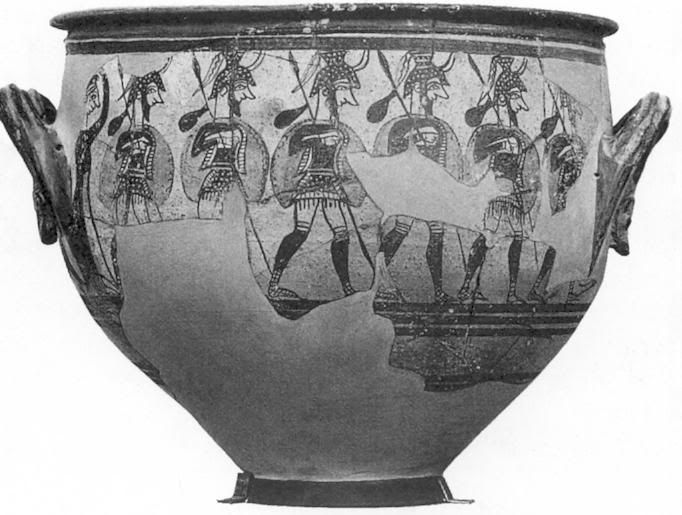 From Mycenae, Greece. Height 16". Ceramic. There is a narrative on the vase describing a woman saying goodbye to a group of helmeted men. The only sign of the woman's emotion is her arm raised to her head.
From Mycenae, Greece. Height 16". Ceramic. There is a narrative on the vase describing a woman saying goodbye to a group of helmeted men. The only sign of the woman's emotion is her arm raised to her head.
Two Women with a Child C. 1400-1200 BC
From palace at Mycenae Greece. Height 2 3/4". Product of Minoan-Mycenae artistic exchange. Observes natural forms in an intricately interlaced position. Carved entirely in the round. Thought to be a generational statue (possibly grandmother, mother, and child) since there are no symbols as to identifying the subjects, but it could easily be two nymphs caring for a child god.
Corbel-Vaulted Casemate C. 1365 BC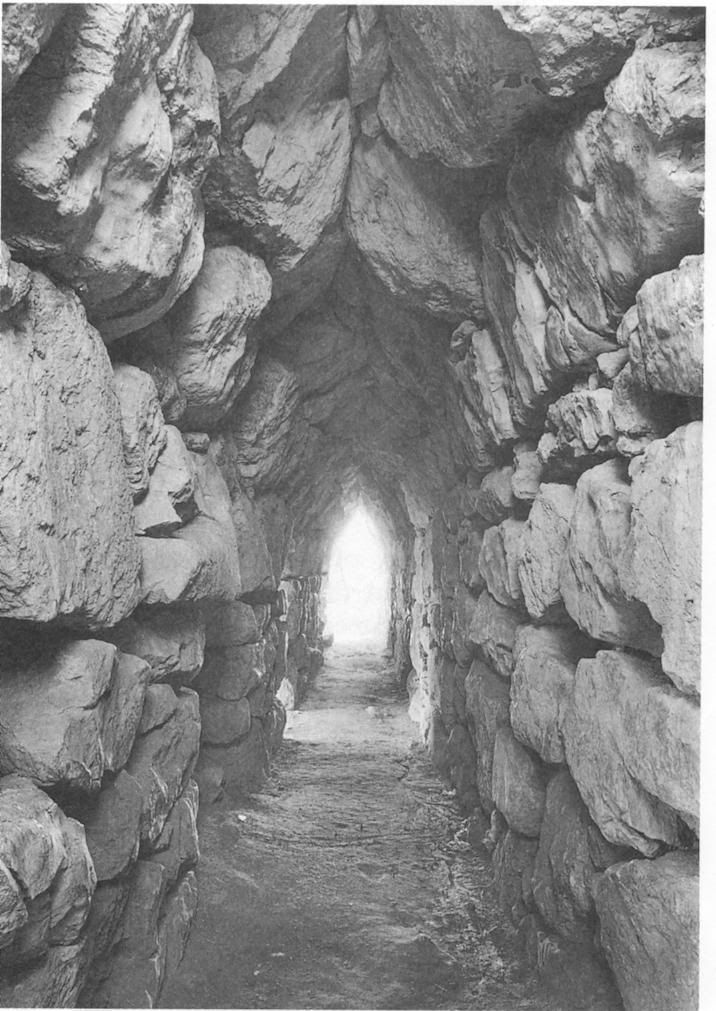 From citadel at Tiryns. The citadel built near coast did not have many natural defenses, this was made up for by the strong defenses built into the citadel itself. The fortress had outer (ring) walls that were 20 feet thick, and the inner walls were massive as well. The casemate here provides space for storing arms and sheltering soldiers or townspeople.
From citadel at Tiryns. The citadel built near coast did not have many natural defenses, this was made up for by the strong defenses built into the citadel itself. The fortress had outer (ring) walls that were 20 feet thick, and the inner walls were massive as well. The casemate here provides space for storing arms and sheltering soldiers or townspeople.
Tholos, the so-called Treasury of Athens C. 1300-1200 BC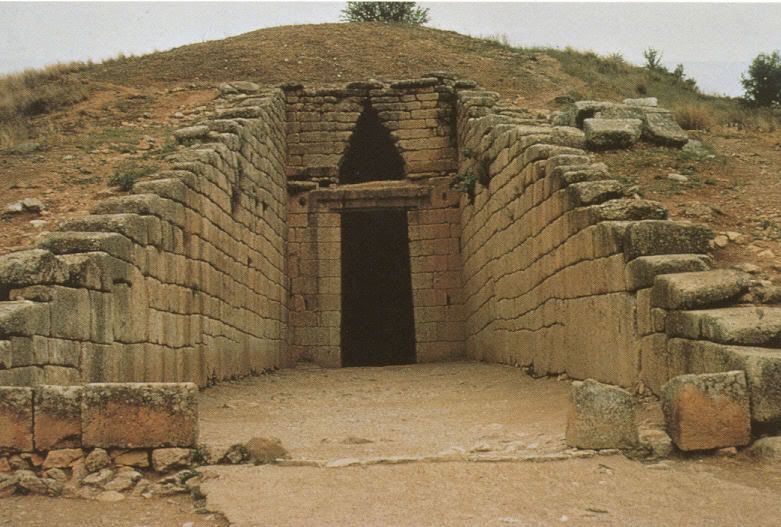 From Mycenae, Greece. Example of Cyclopean construction because it was thought that only Cyclopes were able to move the massive stones. Walled passageway covering the tomb that led to the entrance was about 20 feet long and 20 feet wide. Original entrance was over 34 feet high and covered with bronze plaques.
From Mycenae, Greece. Example of Cyclopean construction because it was thought that only Cyclopes were able to move the massive stones. Walled passageway covering the tomb that led to the entrance was about 20 feet long and 20 feet wide. Original entrance was over 34 feet high and covered with bronze plaques.
Mask of Ag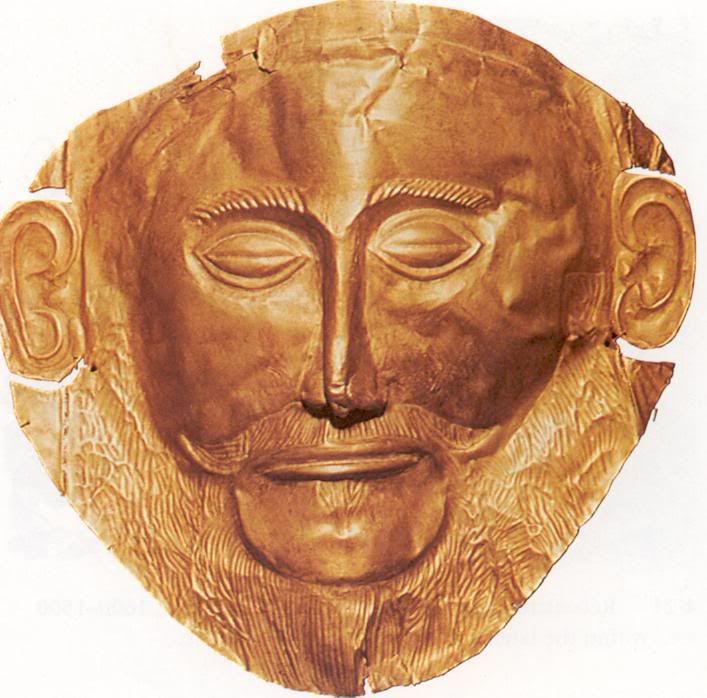 amemnon C. 1600-1550
amemnon C. 1600-1550
From Mycenae, Greece. Gold. Height 12''. Funerary mask. Found by Shiliemann, he assumed the mask to be that of Homer's hero, Agamemnon, but really, it has nothing to do with the Trojan war. The characteristics that make the mask to gallant are the very same features that make people doubt it's authenticity, such as the handle bar mustache
Height of sculpture 9'6". Limestone relief. Gateway to citadel at Mycenae. Reminder to cities war-like past. Proposed of megaliths. 2 9'' tall lions guardians in triangle forms. Their heads, now missing, were made separately of stone, wood, bronze, or gold.
"Flotilla" Fresco: c . 16050 BCE.
. 16050 BCE.
From Room 5 of West House in Akrotiri, Thera, Second Palace period. Painting shows the port of Akrotiri with boats, dolphins, boats, and villages. Akrotiri was destroyed 3,500 years ago from a volcano to form the current island Thera (one of the Cycladic Islands in the southern Aegean Sea).
Two figures of Women: c. 2500-2200 BCE.
From the Cyclades. Made of marble. Height: 13'' and 25''. Shows Cycladic art with pared-down, elegant rendering of the figure. They are also not far removed from the marble slabs. Heads are titled back, arms folded, and toes pointed down to show the figures were intended to lie on their backs as if to be asleep or dead. The anatomical detail as also been kept to a minimum. Statues were originally painted facial features hair, and ornaments in black, red, and blue. Possibly a votive figure.
Seated Harp Player: 3rd millennium BCE.
Fro m Keros, Cyclades. Made of marble. Height 11 1/2''. Fully developed sculpture in the round but similarly simplified like the two women figurines. Best characterized as a musician, particularly a harpist: on a chair, head tilted back as if singing, knees and feet apart for stability, arms raised, bracing instrument with one hand and the other plucking. Possibly a votive figure.
m Keros, Cyclades. Made of marble. Height 11 1/2''. Fully developed sculpture in the round but similarly simplified like the two women figurines. Best characterized as a musician, particularly a harpist: on a chair, head tilted back as if singing, knees and feet apart for stability, arms raised, bracing instrument with one hand and the other plucking. Possibly a votive figure.
Reconstruction of the palace complex, Knossos: Site occupied 2000-1375 BCE.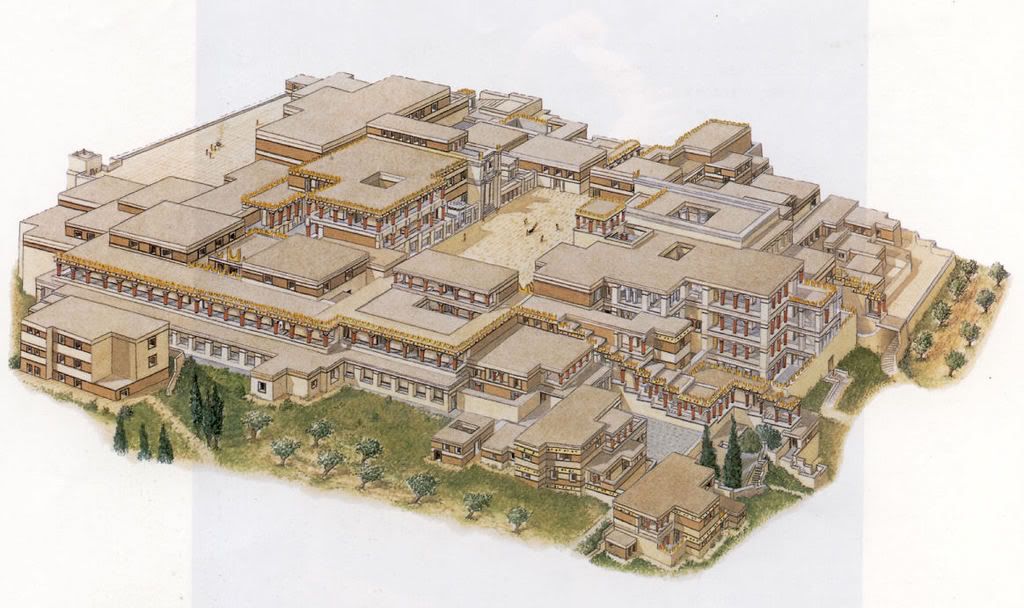
From Knossos, Crete. Complex begun in Old Palace period (c. 1900-1700 BCE). Complex was rebuilt after earthquakes and fires during Second Palace period (c. 1700-1450 BCE). Final destruction was in c. 1375 BCE. British archaeologist Sir Arthur Evans, discovered this areas of the Minoan civilization. Building structures often focused on special landscape features like the sacred Mount Ida. Complex contained a large central courtyard, granaries, storage pits, theater/performance area, independent rooms with eight or nine suites.
Kamares Ware jug: c. 2000-1900 BCE.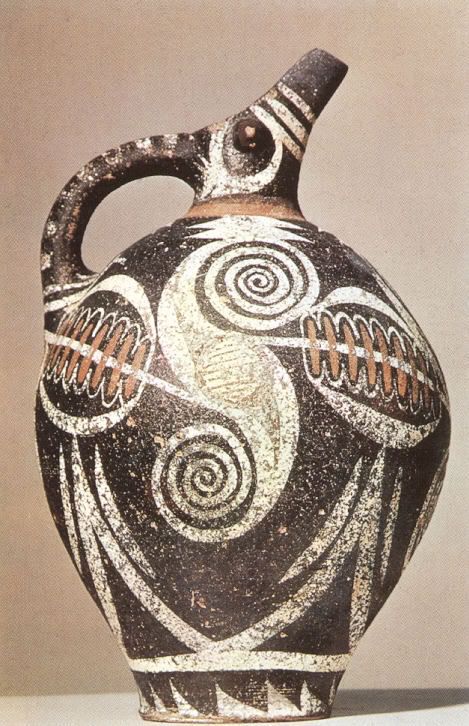 From Phaistos. During the Old Palace Period. Made of ceramic. Decorated with brown, red, and creamy white pigments on a black body. Height: 10 5/8. Based on the hallmarks it was thought to be exported as far away as Egypt and Syria. Has a globular body and a "beaked" pouring spout. The jug has rounded contours complemented by bold, curving forms derived from plant life.
From Phaistos. During the Old Palace Period. Made of ceramic. Decorated with brown, red, and creamy white pigments on a black body. Height: 10 5/8. Based on the hallmarks it was thought to be exported as far away as Egypt and Syria. Has a globular body and a "beaked" pouring spout. The jug has rounded contours complemented by bold, curving forms derived from plant life.
Court with st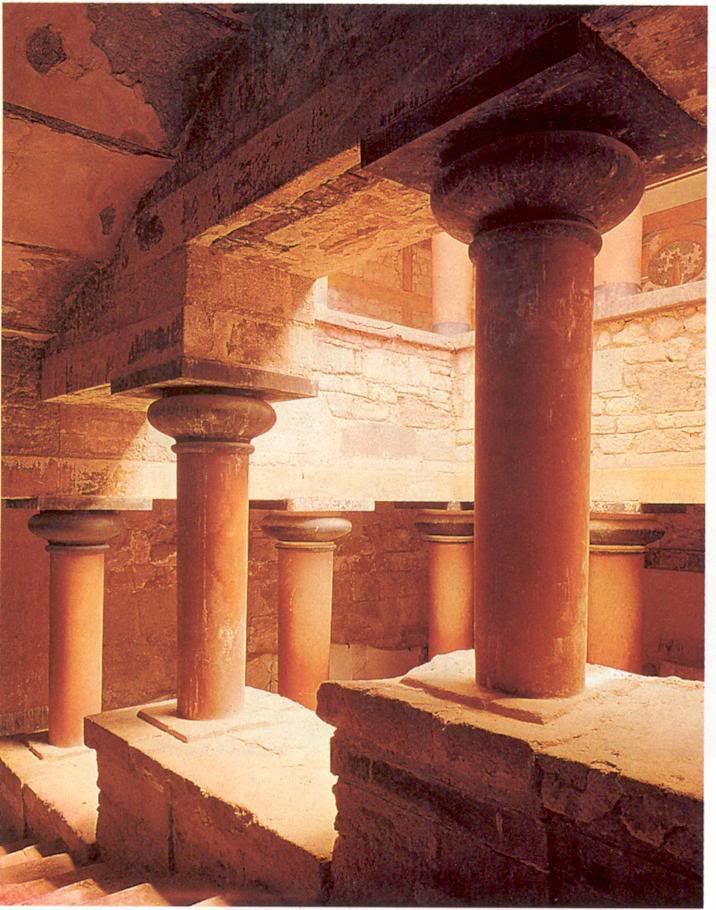 aircase reconstructed by Sir Arthur Evans: Leading to the southeast residential quarter, palace complex, Knossos, Crete.
aircase reconstructed by Sir Arthur Evans: Leading to the southeast residential quarter, palace complex, Knossos, Crete.
Hall is supported by uniquely Minoan-type wood columns that became standard in Aegean palace architecture. The top of the columns that supported the massive roof beams and a broad flattened capital was wider that the bottom. Was arranged around a central space (rather that along a long axis).
Bull leaping, wall painting with areas of modern reconstruction, from palace complex, Knossos, crete. Late Minoan period C 1450 – 1375 BCE, about 24 ½" tall. One of the best preserved paintings. May represent initiation of fertility ritual. Shows 3 youthful people with a large bull in the center. The frame is made of overlapping ovals, chariot-wheel motif in between stripped bands.
Late Minoan period C 1450 – 1375 BCE, about 24 ½" tall. One of the best preserved paintings. May represent initiation of fertility ritual. Shows 3 youthful people with a large bull in the center. The frame is made of overlapping ovals, chariot-wheel motif in between stripped bands.
Octopus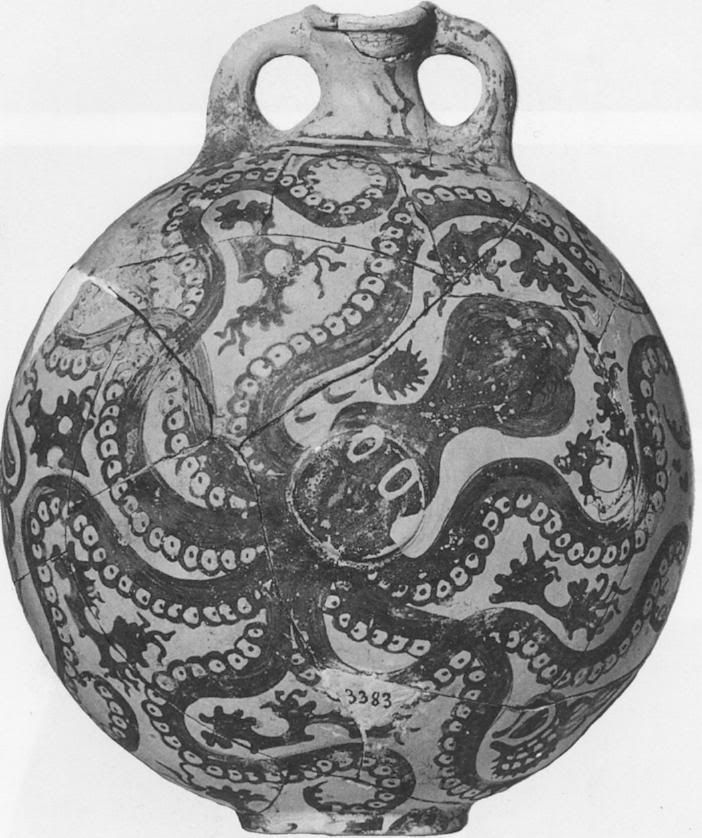 flask, palai kastro, crete,
flask, palai kastro, crete,
second palace period, C 1500-1450 BCE> marine style ceramic 11" tall. The marine style was when sea life was painted on pottery. Many sea creature surround the octopus, in between his tentacles. Image stylized in harmony with the vessels shape.
Harnester vase-Hagia Triada Crete.
Bull's head rhyton, from palace complex, knosses, crete,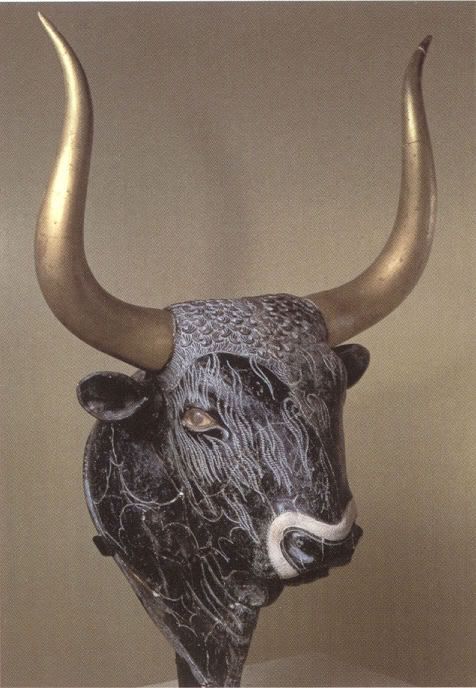
second palace period. C1550-1450 BCE. Steate with shell, rock crystal, red jasper, restored gift wood horns 12" tall. Bulls appear very often in Minoan art. Rhytons were also made in bullform. Bull's horns covered with gold leaf, white shell for nose outline, red jasper for eyes. Used for serving ritual fluid, poured into neck and goes out through the mouth.
Vapheio cup, found near Sparta, Greece,
C. 1650-1450 BCE, gold, 3 ½" tall. One of 2 gold cups found in a large tomb in Vapheio. Relief done in repoussé, the technique of hammering from the back of the sheet. Handles attached with rivets, lined with a sheet of gold. Depicts different forms of bulls. Maybe sacred scene of a sacred grove.
Citacel, Mycenae, Greece, site occupied
C. 1600 – 1200 BCE, wall built C. 1340, 1250, 1200 BCE. Hilltop position, Lion Gate is in the lower left, near east coast of the Peloponnese peninsula, of the leader of the Greek army that conquered Troy.
Posted by
Christina
at
10/12/2007 07:39:00 PM
0
comments
![]()
![]()
Labels: Art History, images
